#i wanted each character to feel more individualistic so adjustments had to be made
Explore tagged Tumblr posts
Text
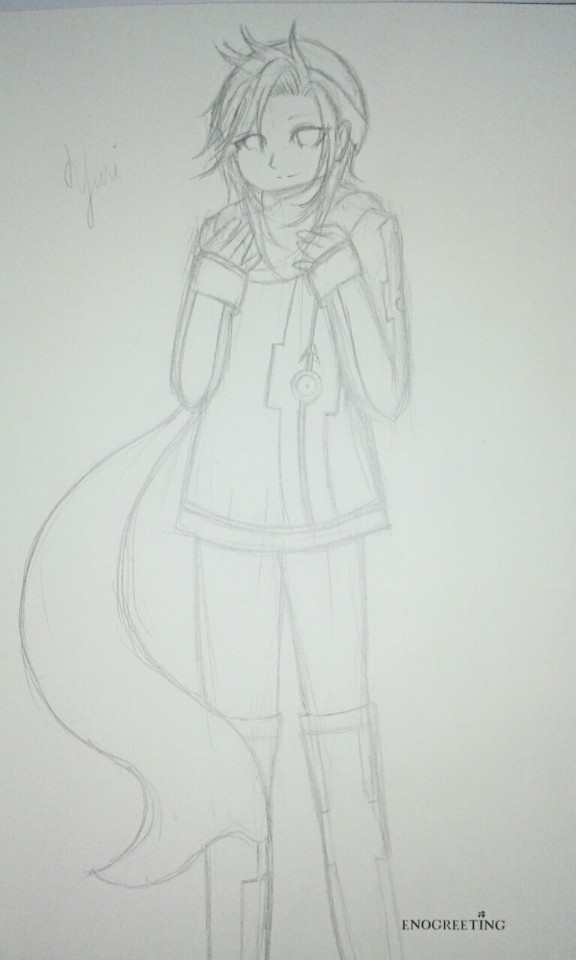
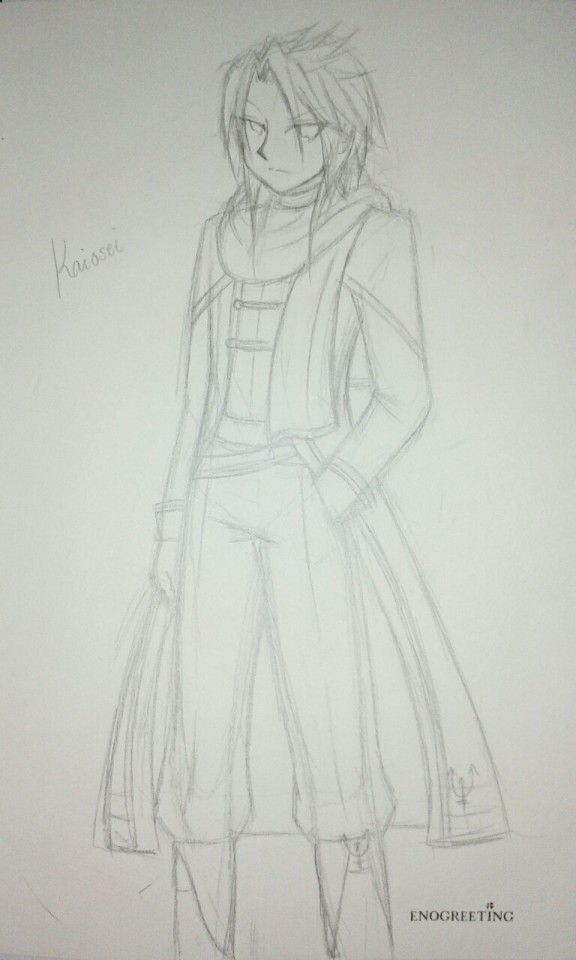
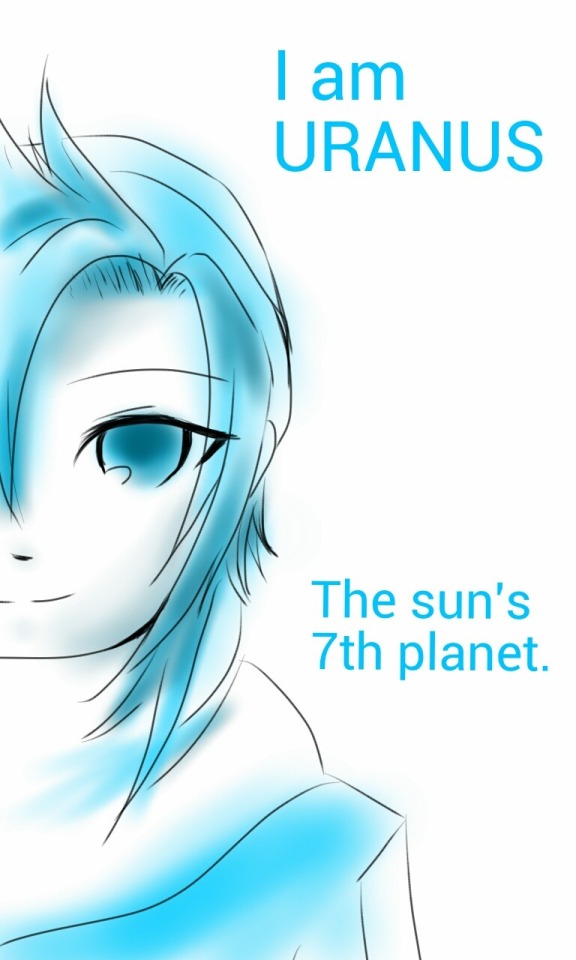
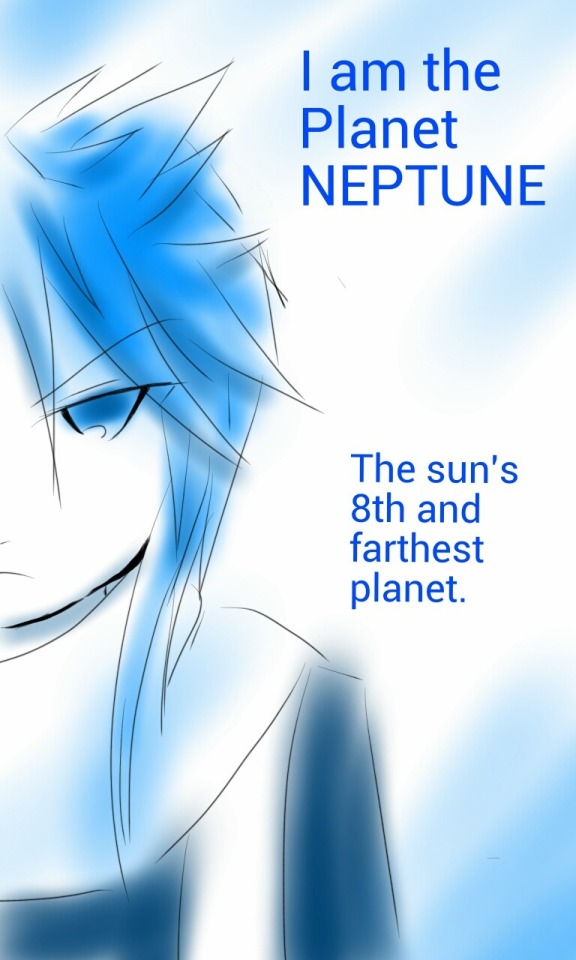
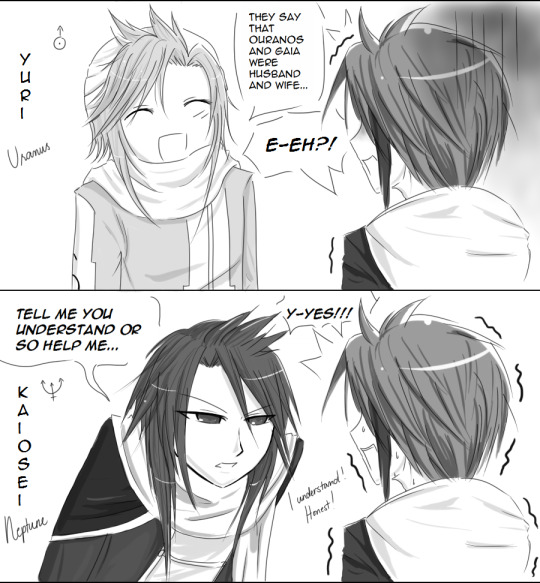
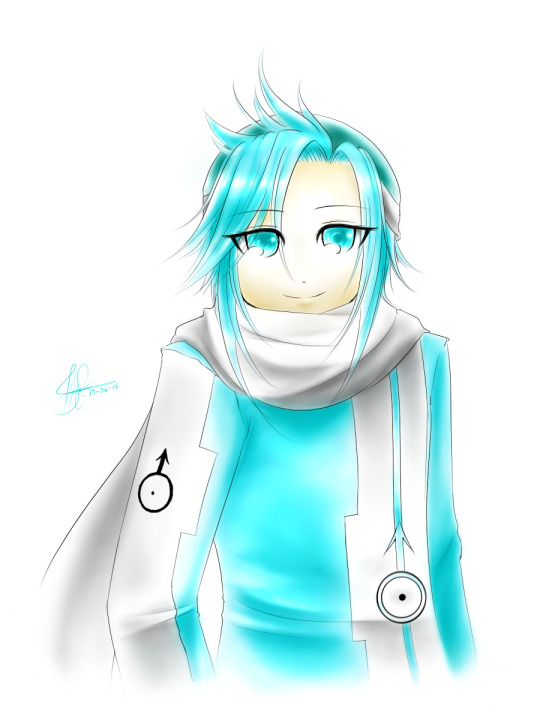

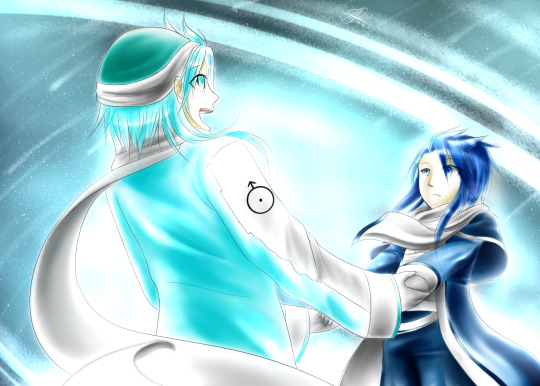







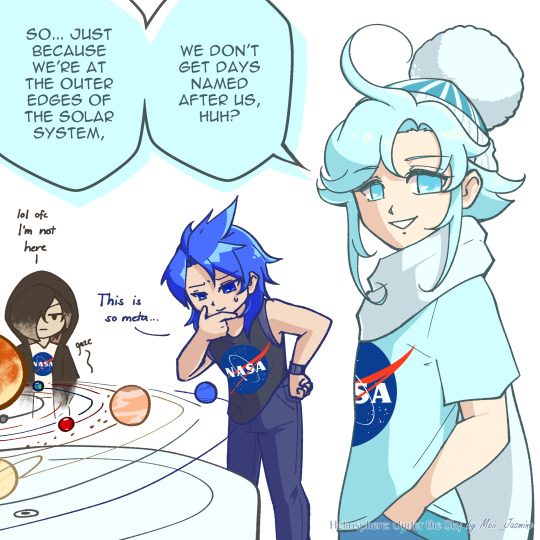
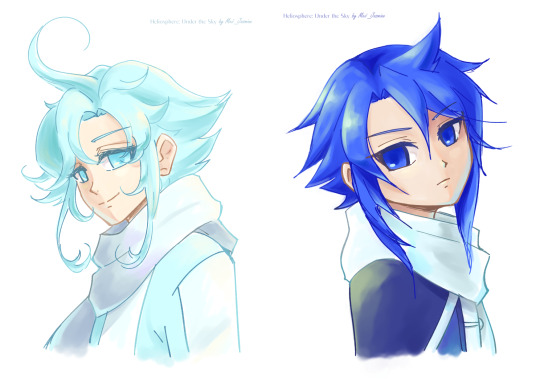
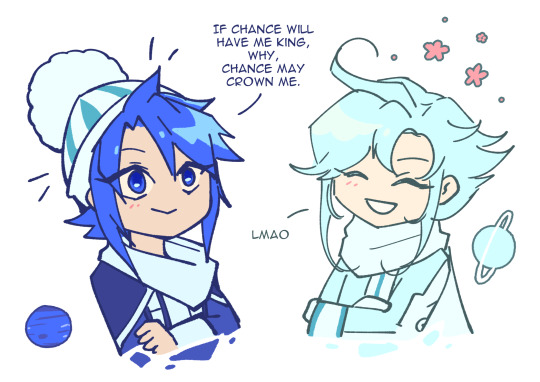

Uranus and Neptune's transformation through the years!
(in picture set: 2014-2023)
Original concepts from 2014 vs now:
Uranus
Before: Actual airhead, eccentric, chaotic, little to no regard for Neptune's boundaries. Regardless, he still loved his brother dearly, and his moons. Had a much higher voice too, always smiling. Now: Still eccentric, still always smiling, but nobody can seem to read his true intentions. May look sweet and friendly but is actually a little intimidating. Far more intelligent, doesn't seem to be easily emotionally swayed.
Neptune
Before: Cold, stern, no-nonsense and scary. Quite dominant. Not evil, but not soft either. Very serious. Pragmatic, but has a soft spot for his brother. Now: Textbook INFP. Introverted soft boy, emotional and sensitive, always wants the best for everyone. May look a little intimidating but he's actually really sweet. He's powerful in his own right, but doesn't want to use it for what he deems is immoral.
#art#uranus#neptune#kaiousei#jupiter#saturn#jove#cronus#throwback#art compilation#solar system#solar system gijinka#space gijinka#personification#tag commentary#i'm not gonna lie: i miss the old uranus and neptune but i think i like this current dynamic better#mars and jupiter got all of neptune's former traits. earth got even more of his carefree nature from uranus#i wanted each character to feel more individualistic so adjustments had to be made#so no more earth 2.0 and cold mars/jupiter 2.0#also (raises hand) i'm also INFP hahaha#i may make even more adjustments to neptune in the future. like his gloves and coat details#but yuri is more or less set in stone. he's one of the designs i really enjoyed working on even back in 2014#HUtS yuri
12 notes
·
View notes
Text
bubble bubble toil and trouble / have you seen [ sybill trelawney ] ? i heard that they are [ neutral ] to the war or avoiding it all together ! [ she/they ] is/are [ agender ] and [ twenty three ] ! they are often mistaken for [ jessica sula ] and known to be [ individualistic and gloomy ] ! i wonder if they’ll survive the war.

LINKS: pinboard, stats page
HISTORY
sybill trelawney’s parents were not in love. in all truth, they barely knew each other --- her father, a wizard, and her mother, a muggle, met at a university party. one thing led to another, and a few months later, odin trelawney received a phone call from a girl he didn’t really remember. shit. “i’m pregnant,” she said. “and it’s yours.” and odin, you see, was a honourable man, of some sorts, and drove over there ( he’s an halfblood, quite well versed in the ways of the muggle world ) and discussed their options.
he would take care of the child, they decided, become the main caretaker. that was what he wanted --- mary had no drop of magical blood in her veins, and it’d be easier for their child, should she grow up with a magical parent. and so it was decided. sybill trelawney was born, named after a famous seer from the middle ages, and grew up with her father alone.
and from him she learned about their family’s history. about cassandra, and how her sight might reappear in her. how he hoped it would. how she should tell him when it did. sybill tried to predict, tried to see into the future, to touch that realm. she often failed. she made small predictions to see if they’d come true. they often didn’t, they sometimes did. she wanted to make her father proud, to make sure the trelawney legacy would not pass another generation and come closer to dying out
growing up, sybill attended muggle elementary. she saw her mother every now and then. she drove in her dad’s car and was surrounded by both muggle and magical culture through her whole life. she liked that. she liked finding balance in both those things, she loved combining it. sybill was a happy child, but a thoughtful and quiet one. withdrawn, always fussing about her decisions, always trying to be what she thought the people around her wanted of her.
hogwarts rolled around, and she was sorted into ravenclaw there. a house that fit her perfectly ( and the hat didn’t take long to decide because of that ). sybill was once again quiet and reserved, but eccentric in her ways when she was not. she was adequate at her classes, excelling at divination, astrology and charms, and not much more.
she learned that she did possess the gift, at hogwarts. that it was fickle and hard and not always as present as it could be, but it was there, inside her. she became more vocal about it, started calling herself a seer, reminding people of her relation to the cassandra trelawney. she’d make up predictions, learn how to make ones that would most likely come true, just so people would believe her more. and if they didn’t, that was on them.
sybill learned soon, too, that all the predictions that hit her were negative. she saw death all around her. tragedy. pain. loss. it swallowed her whole, and made her more reclusive, made her more determined to make her sight grow and her mouth sewed shut when she was about to make a more gloomy prediction. sometimes the line between thought up and true predictions became blurred. she wanted to become better at this, but there was no getting better at it. her sight was just that --- limited, but there.
she had nightmares about people dying and wasn’t sure if they were nightmares or visions. she wasn’t sure. she couldn’t be sure, not ever. her self doubt she never voiced --- she just kept making small predictions that often came through, because that was the way the world spun. glasses break. horrible things happen. if people wanted to believe in the things she said, they often happened.
[ alcoholism tw she became dependent on bottles of sherry and red wine in her sixth year, slowly growing more used to the dulling sense of alcohol on her brain. she felt more clear headed, when she wasn’t sober, as if she could distinguish her thoughts better. she knew she shouldn’t, but it worked, and she was so tired of all the fatalistic thoughts swirling through her head all the time. end of tw ]
after graduation, sybill didn’t know what to do. she sought for jobs, using her ancestry and slight skill as a selling point. she washed dishes for a while, read tealeaves for a small price on the side, wrote the astrology section for the daily prophet for a while. nothing felt right. nothing was right. there should be more that she should be doing with the little gift she did have, especially with the horrible things happening in the world, but there were little opportunities, too much cynicism.
her lies grew. she made up more predictions, grew unreliable. her sight became clouded by her own dishonesty. people kept dying and she wondered if those were the people she dreamed about or if those were just others. sometimes, she even doubted if she was truly a seer, or if she was just lying to herself as well.
her father was proud, at least. he believed in her sight. he believed that all she said was true. he beamed and patted her head and told her that the whole family was so proud of her. sybill just smiled and nodded and kept going.
she was married, for a short while. it lasted shorter than kim and kris’ marriage. i’m not joking. they kept it going for two months and then filed for divorce, because sybill had not taken her husband’s last name ( higglebottom, i mean ) and he wasn’t very pleased with it. of course, there were other issues --- sybill had romanticised what was happening between them, and martin, her now ex-husband, was disillusioned ( which isn’t strange, considering the amount of lies sybill tells ).
it did definitely break sybill’s trust in love. she’s a romantic, but that made her cynical, too. a cynical romantic seer, who constantly feels the deaths of people coming --- no wonder that she feels like she’s spiraling. she doesn’t see martin much any more, these days, and their divorce was almost three years ago now.
[ alcoholism mention right now, she has her hopes set on working at hogwarts. she’s been owling with dumbledore, has been trying to work on her resume, to make herself more credible. she’s trying to stop drinking, to become clearer of mind. she’s trying, trying, trying, because she wants to do something that makes her feel whole, because she’s never really felt whole at all end of mention ]
so as we all know, once sybill’s interview rolls around, she will make her famed prophecy and end up working at hogwarts ( good for her tbh, she deserves it ), but we’re not just yet there. nearly, though. it’s coming.
CURRENTLY AND PERSONALITY
sybill is a Character, let me tell you that. she’s very good at being on her own, and in all honesty, quite an independent being. she longs for many things, but doesn’t dare say them out loud.
i think the main problem is that sybill never really felt like she belonged. she comes from a broken home, and while she loves her dad, home was always so empty and quiet and lacking. elementary school was a place where she didn’t fit in, and even at hogwarts, she struggled. she sometimes feels like a ghost of a being, moving through the world invisible, head in the clouds.
she’s not shy, though, not per se. reserved, yes, and quiet upon first glance, but once she gets talking, her dramatics and eccentricity do show up. she’s enthusiastic about the things that make her heart beat faster --- art and poetry and the stars and divination, too.
runs an astrology instagram, lmao. will make up your astrology chart. she’s a pisces sun, libra moon herself!!
Aesthetically Pleasing as hell. she loves fashion and combining muggle and wizarding fashion and she’s trying to learn to sew a little so she can make more original outfits. she’s got a bit of a quirky style, but a solid one. loves mary jane’s and cute socks, mostly.
sybill’s agender because in all honesty, she thinks gender is a sham. she just doesn’t connect with any identity but agender, with subscribing to absolutely nothing. she’s still figuring it out, mostly goes by she/her pronouns in public, but she has many days where she prefers they/them.
makes a mean sangria
very often wears sunglasses, even when inside. for the aesthetic, against headaches and ‘because not wearing them tires out my inner eye’
has a dry, stupid sense of humour that we all stan
loves stargazing. hopeless romantic.
a bit of a chameleon. sybill is a very skilled liar, and can be whatever you want her to be, and she has no trouble adjusting to that. her sense of self is a bit limited, but she doesn’t mind. she doesn’t know if she’d like the real her.
lmao she loves playing the sims that’s that on that!!!!
this is my first time playing her and im scared bYE
2 notes
·
View notes
Text
Dark blue hair trend: 15 fantastic examples to note
Having dark blue hair is a high end fashion hair color that expresses the rebel side of your personality! It is a mysterious but wearable color that miraculously transforms your mane into a very individualistic, outstanding hair as deep as the midnight sky.
It is never uniqueness and subtlety to prevent bold fashion statements from being made. That's why it's coming up with the charts for the most edgy hair colors that rock celebrities and influencers! Note, however, that some variations of dark blue hair are better applied with hair dyes by a professional colorist.
It is the key to lightening your streaks first, if you want a real living result. Blue-black hair flatters any complexion with its customizable hues, and wearing this denim color with textures lets you brag about the natural highlights and dimensions that it possesses.
Take the car and try a fashionable dark blue hair color from this recently updated and exclusive collection of photos for your inspiration!
dark purple
This midnight blue hair was achieved by first lightening the hair to make a vibrant cerulean blue.
dark gray
How would you describe this look?
This look is a smoke blue balayage. The coolest thing is the dimension of my guest's natural hair color, which contrasts with the blue. For styling, we curled up with a 1 1/2 in curling iron to create an effortless beach wave.
Any advice for someone who is considering it?
Keep the color by refreshing it about once a month. In addition, it usually takes several sessions to bring the hair to the desired level to achieve the smoke blue color. Home maintenance is a must. Be sure to use color-safe shampoo and conditioner and some heat protection before curling.
Light blue to dark blue ombre
How would you describe this look?
This is called "blue ombré" or as I called black charcoal to blue fire. I love that look because the darkness of the black, graduating into the vibrancy of the blues, makes that look "subtle" and alive. Ombré is a great way to blend in your natural hair into a color that can easily outgrow and later be cut off.
Any advice for someone who is considering it?
Lively hair color is extremely easy to care for and requires a lot of care. Professional products are highly recommended as well as a routine of cold water and rare shampooing.
"Vivids" are beautiful, but they bleed and fade, so white pillowcases become white sheets, white shirts, blue. When it's summer you need to avoid swimming pools at all costs or say goodbye to the living hair and hello to green. The colors color your hands and you are tub / shower, so be ready.
Also a correction between the dates is urgently recommended, in order to keep aliveness. I think living hair is great for any person, regardless of age and gender. It's a fun way to change your look.
navy
How would you describe this look?
This style for me is edgy, but elegant. The layer really gives the curls movement and combined with the color makes me think of ocean waves.
Any advice for someone who is considering it?
This blues sound does not bang, so I think it would be great for someone to test the waters of the fashion colors. Every shadow of the rainbow is not for the low-maintenance person. It usually means longer appointments in the salon and more home maintenance. That does not mean it's not fun! If you are looking for some hair that matches your bright, outgoing personality, try it!
Dark sapphire
How would you describe this look?
This haircut is a long modern shag. Sabrina has a lot of very thick hair and I wanted to create a weightless style with a lot of movement.
The coolest part is the edge area. It's a kind of full blown version of Curtain Pony, with the shortest point in the middle around her lip and fanning down around her pines. I feel like this type of fringe will make a huge return, it's versatile, customizable and can add a lot of style to a haircut without changing the overall shape.
I like to call this color Midnight Blue. This color works for Sabrina because of course she has dark features with cool undertones. The key is that although it is technically a vivid color, it is still deep and saturated so it will not wash it out.
Any advice for someone who is considering it?
Get a good regime of salon quality products. Although the blue color is on the darker side, we still had to lift it a bit to get the clarity of the tone, so quality products are a must. Talk to your stylist, they will let you know if your hair is in good condition to handle such a process.
Since Sabrina's hair is naturally dark and you do not mind the dark at the root when it grows out, the care for her is very minimal. She uses Celeb Luxury Viral Shampoo in extreme blue once or twice a week to keep the dark blue hair color alive and shiny. As far as the cut and style are concerned, this will work for almost anyone with medium to thick hair straight to wavy. The length of the layers, the length of the pony and the face frame can be adjusted to fit most shapes.
Black and dark blue highlights
How would you describe this look?
This beautiful blue hair was obtained by Joico colors of Sapphire Blue and Cobalt Blue hair dye. The colors were made in panels so that they would melt beautifully on top of each other. The cut was made with a one-length haircut, a face frame to flatter the jaw of the client's face and shattered layers to give as much body / movement as we could. My client has very fine hair, so we do as much as possible to keep the body full on the ground, but still have a lot of movement in the middle shaft.
Any advice for someone who is considering it?
My advice to wear this seductive look would be a bold, funny, sassy character who has a simple job. A company that does not mind having such a fun look represents their company. It requires the client to use a colored conditioner between color applications to keep the liveliness alive. Also, wash with a colourfast shampoo with cold water. This will help to keep the dark blue hair color from fading.
Dark neon blue
Get electrically charged with this cool mermaid-sea hair! If you're ready to commit to maintenance, this funky look is sure to serve you the best as long as you want!
Metallic dark blue
We are obsessed with these wonderful thick waves interwoven with midnight black and navy. Stylist Tessarah tips that patience is an ingredient needed to own this artwork, as all good things take time!
Short blue hair
Who would not be over the top with this great ultramarine bob head ?! This sleek and upscale look is perfect for women who have the confidence and elegance to wear it.
Medium length Dark blueberry
Join the azure color cult with this stunning navy blue on layered chest strings. Keep your natural roots untouched for easier growth!
Color brown to dark blue
How about some lively cyan to shake your layered brunettes? This mix is definitely unique!
Dark color on long hair
Have a unique color melt as you mix these shades of turquoise and black curls together! The result is really shiny and defined on long wavy hair.
midnight Blue
This has a magnificent azure on a slender bob, which is rounded at the back and goes dull forward, which gives you a mysterious and refined atmosphere.
Dark to light lavender ombre
This amethyst-inspired tone on a wavy mane is mesmerizing! Keeping your roots a dark natural color makes it easier to grow and blends well with the silver ends for a nice contrast.
Curly dark blue hair
What better way to showcase your sea-inspired dark blue hair than with amazing texture? In this way you catch the light and show an incredible shine.
Dark blue hair trend: 15 fantastic examples to note
0 notes
Text
Dark blue hair trend: 15 fantastic examples to note
New Post has been published on https://www.easypromhairstyles.com/dark-blue-hair-trend-15-fantastic-examples-to-note.html
Dark blue hair trend: 15 fantastic examples to note
Having dark blue hair is a high end fashion hair color that expresses the rebel side of your personality! It is a mysterious but wearable color that miraculously transforms your mane into a very individualistic, outstanding hair as deep as the midnight sky.
It is never uniqueness and subtlety to prevent bold fashion statements from being made. That's why it's coming up with the charts for the most edgy hair colors that rock celebrities and influencers! Note, however, that some variations of dark blue hair are better applied with hair dyes by a professional colorist.
It is the key to lightening your streaks first, if you want a real living result. Blue-black hair flatters any complexion with its customizable hues, and wearing this denim color with textures lets you brag about the natural highlights and dimensions that it possesses.
Take the car and try a fashionable dark blue hair color from this recently updated and exclusive collection of photos for your inspiration!
dark purple
This midnight blue hair was achieved by first lightening the hair to make a vibrant cerulean blue.
dark gray
How would you describe this look?
This look is a smoke blue balayage. The coolest thing is the dimension of my guest's natural hair color, which contrasts with the blue. For styling, we curled up with a 1 1/2 in curling iron to create an effortless beach wave.
Any advice for someone who is considering it?
Keep the color by refreshing it about once a month. In addition, it usually takes several sessions to bring the hair to the desired level to achieve the smoke blue color. Home maintenance is a must. Be sure to use color-safe shampoo and conditioner and some heat protection before curling.
Light blue to dark blue ombre
How would you describe this look?
This is called "blue ombré" or as I called black charcoal to blue fire. I love that look because the darkness of the black, graduating into the vibrancy of the blues, makes that look "subtle" and alive. Ombré is a great way to blend in your natural hair into a color that can easily outgrow and later be cut off.
Any advice for someone who is considering it?
Lively hair color is extremely easy to care for and requires a lot of care. Professional products are highly recommended as well as a routine of cold water and rare shampooing.
"Vivids" are beautiful, but they bleed and fade, so white pillowcases become white sheets, white shirts, blue. When it's summer you need to avoid swimming pools at all costs or say goodbye to the living hair and hello to green. The colors color your hands and you are tub / shower, so be ready.
Also a correction between the dates is urgently recommended, in order to keep aliveness. I think living hair is great for any person, regardless of age and gender. It's a fun way to change your look.
navy
How would you describe this look?
This style for me is edgy, but elegant. The layer really gives the curls movement and combined with the color makes me think of ocean waves.
Any advice for someone who is considering it?
This blues sound does not bang, so I think it would be great for someone to test the waters of the fashion colors. Every shadow of the rainbow is not for the low-maintenance person. It usually means longer appointments in the salon and more home maintenance. That does not mean it's not fun! If you are looking for some hair that matches your bright, outgoing personality, try it!
Dark sapphire
How would you describe this look?
This haircut is a long modern shag. Sabrina has a lot of very thick hair and I wanted to create a weightless style with a lot of movement.
The coolest part is the edge area. It's a kind of full blown version of Curtain Pony, with the shortest point in the middle around her lip and fanning down around her pines. I feel like this type of fringe will make a huge return, it's versatile, customizable and can add a lot of style to a haircut without changing the overall shape.
I like to call this color Midnight Blue. This color works for Sabrina because of course she has dark features with cool undertones. The key is that although it is technically a vivid color, it is still deep and saturated so it will not wash it out.
Any advice for someone who is considering it?
Get a good regime of salon quality products. Although the blue color is on the darker side, we still had to lift it a bit to get the clarity of the tone, so quality products are a must. Talk to your stylist, they will let you know if your hair is in good condition to handle such a process.
Since Sabrina's hair is naturally dark and you do not mind the dark at the root when it grows out, the care for her is very minimal. She uses Celeb Luxury Viral Shampoo in extreme blue once or twice a week to keep the dark blue hair color alive and shiny. As far as the cut and style are concerned, this will work for almost anyone with medium to thick hair straight to wavy. The length of the layers, the length of the pony and the face frame can be adjusted to fit most shapes.
Black and dark blue highlights
How would you describe this look?
This beautiful blue hair was obtained by Joico colors of Sapphire Blue and Cobalt Blue hair dye. The colors were made in panels so that they would melt beautifully on top of each other. The cut was made with a one-length haircut, a face frame to flatter the jaw of the client's face and shattered layers to give as much body / movement as we could. My client has very fine hair, so we do as much as possible to keep the body full on the ground, but still have a lot of movement in the middle shaft.
Any advice for someone who is considering it?
My advice to wear this seductive look would be a bold, funny, sassy character who has a simple job. A company that does not mind having such a fun look represents their company. It requires the client to use a colored conditioner between color applications to keep the liveliness alive. Also, wash with a colourfast shampoo with cold water. This will help to keep the dark blue hair color from fading.
Dark neon blue
Get electrically charged with this cool mermaid-sea hair! If you're ready to commit to maintenance, this funky look is sure to serve you the best as long as you want!
Metallic dark blue
We are obsessed with these wonderful thick waves interwoven with midnight black and navy. Stylist Tessarah tips that patience is an ingredient needed to own this artwork, as all good things take time!
Short blue hair
Who would not be over the top with this great ultramarine bob head ?! This sleek and upscale look is perfect for women who have the confidence and elegance to wear it.
Medium length Dark blueberry
Join the azure color cult with this stunning navy blue on layered chest strings. Keep your natural roots untouched for easier growth!
Color brown to dark blue
How about some lively cyan to shake your layered brunettes? This mix is definitely unique!
Dark color on long hair
Have a unique color melt as you mix these shades of turquoise and black curls together! The result is really shiny and defined on long wavy hair.
midnight Blue
This has a magnificent azure on a slender bob, which is rounded at the back and goes dull forward, which gives you a mysterious and refined atmosphere.
Dark to light lavender ombre
This amethyst-inspired tone on a wavy mane is mesmerizing! Keeping your roots a dark natural color makes it easier to grow and blends well with the silver ends for a nice contrast.
Curly dark blue hair
What better way to showcase your sea-inspired dark blue hair than with amazing texture? In this way you catch the light and show an incredible shine.
0 notes
Photo

Aoi Yamaguchi: Breaking From Tradition
Japan has five main islands, and Hokkaido is the northernmost island. It’s known for its distinctive four seasons, beautiful landscapes, snow-covered mountains, rolling hills, and huge farms boasting fine dairy and cheese. In comparison to Tokyo, Kyoto, and more central areas of Japan, Hokkaido has a slower pace of life. Japanese calligrapher Aoi Yamaguchi was born and raised in Hokkaido, and trained under renowned Master Zuiho Sato from age six to age 19. Her mother holds the Shihan level of mastery in calligraphy, which certifies her to teach, and was eager to expose Yamaguchi and her younger sister to the craft from an early age.
Yamaguchi’s father was a high school teacher, which required the family to move every two to three years for new teaching assignments. In all, Yamaguchi at tended three elementary schools and two high schools. Regardless of how far Yamaguchi’s family moved from Master Sato, they consistently made time to continue advancing her calligraphy skills. And when Yamaguchi attended four universities in California before graduating, her calligraphy practice was the one constant in her life.
Since she moved to California in 2004, Yamaguchi’s work has blended traditional art forms with modern aesthetics. She merges calligraphy with live visuals for music festivals and down runways at New York Fashion Week. Yamaguchi also teaches calligraphy workshops, creates conceptual calligraphy installations and exhibitions, mounts live performances, and takes on custom logo design and commissioned art works.
Yamaguchi launched her studio in Berkeley in 2010, thanks in part to receiving an O-1 visa, which is given to people who possess extraordinary ability: typically actors, athletes, and musicians – not calligraphers. Here, she discusses what it took to become a master calligrapher, how she collaborates in the live performances, and the ways in which calligraphy bridges languages and cultures.
Yamaguchi photographed in and around Berkeley, California.
What activities did you enjoy as a child? And, how did you begin studying calligraphy under Master Zuiho Sato at age six?
My parents didn’t allow us to play video games, so my sister and I spent a lot of time outdoors. Growing up, I enjoyed hiking in the mountains and wearing tall boots to walk in the river. I started skiing when I was three, and was an active child. I also enjoyed listening to music, dancing, drawing, writing short stories, and took piano lessons after school. When I was six years old, my mother enrolled me in Master Zuiho Sato’s calligraphy school. She had been practicing calligraphy since junior high school, as Japanese calligraphy is a mandatory class in the public school system. I didn’t know anything about calligraphy until then, but it was fun, and I picked up the skill quickly.
“Calligraphy is like karate – until you get the black belt, you have so many ranks to move through.”
Walk me through a typical day studying calligraphy with Master Sato. And how many times a week did you attend class?
I would attend elementary school until 3 p.m., then I go to calligraphy school on Wednesdays. Master Sato converted part of his home into a calligraphy school that could house 30 students. Class was held from 4 p.m. to 5 p.m., depending on the student. Each week, you were given one assignment. The textbook, which is provided by the International Calligraphy Association based in Sapporo, gives you a set of words, like spring or cat, and you write them in Japanese calligraphy. Master Sato would also write other words for you.
All of the kids would gather around the teacher to watch how he moved the brush. Then you’d go back to your seat at the long, wooden table to practice. When you felt confident about your work, you’d take it to the teacher for review. Based on Master Sato’s feedback, you’d go back to your seat and practice further. You would stay until you completed it correctly.
At the month’s end, you would choose your best work with Master Sato and submit it to the International Calligraphy Association. There are 30 or more master calligraphers, like jurors, and they review your work and decide if the student passes or not. In the calligraphy world, there’s a ranking system, and you go through a total of 14 levels throughout the year to see how far you can rise. If you achieve the highest rank six years in a row, you will be become a master student or student master. I received this title when I was 14. Calligraphy is like karate. Until you get the black belt, you have so many ranks to move through.
Thinking back to your six-year-old self, what did you enjoy most about studying calligraphy?
Studying calligraphy is really physical, and I was a perfectionist. I would look at my master’s work and try to write it exactly the same, following his brushstroke. My work wouldn’t come out the same, so I’d get frustrated. However, I’m really persistent, so I would strain my back over a sheet of paper, practicing for hours until I could write something nearly identical to my master. I found this process very meditative. To this day, I love the smell of the sumi ink.
Was there ever a moment when you wanted to quit pursuing calligraphy?
Never. I envision myself being really old, listening to the birds chirping, feeling the sun and wind on my face, and I’m quietly writing calligraphy. I know masters who are age 90, while others start in their 60s or 70s. It’s never too late to start, and you can always quit anytime.
What sacrifices have you made for the craft?
School and life could get busy, but my mother always tried to make time for me and my sister to practice calligraphy together. Although we moved frequently, I continued studying with the same teacher for 14 years. When we moved three hours away from Master Sato, we continued our studies remotely. This was definitely a special case. My mother would teach me how to write a word, and then I’d practice the word and send my work in an envelope to my master. He would correct my work, and send it back to me. Sometimes, my mom would drive me three hours for a private session, and then we’d drive home. Every month, I continued turning in my work to the International Calligraphy Association for review.
Of calligraphy, it’s been said that, “the brushstrokes cannot be corrected, and even a lack of confidence shows up in the work.” Can you talk about the art of trying to achieve perfection in calligraphy?
The calligraphy you work on is the mirror of the self, and your mental state or emotion appears in your work. First, you have to know the movement and remember what comes next. Where is the start? What comes next? And where does the character end? You have to practice until you don’t even think about it. But if you are thinking about other things, like, “Oh, I have to go to the grocery store” while you are writing calligraphy, that unstable mind state shows in your work. It’s hard work to make yourself fully present.
My process is to take a deep breath, meditate, and really focus on the present moment. I’ll just sit there and the only thing I’m doing is thinking about the meaning of the character, and envisioning what kind of strokes I need to write. If I’m writing the character for “ocean,” then I have to become the ocean. Then I see a gray shadowy line appear on the paper, and I trace this in the moment. My mind and body become a conductor of that vision.
How did it feel when you represented Japan at the Fourth Hokkaido Elementary and Junior High Students calligraphy exchange sessions at the Palace of Pupils in China?
I was 14 years old when I went to China as one of 30 master student calligraphers with the chairman of the International Calligraphy Association leading the troupe. It was a weeklong trip where we participated in a calligraphy session with local Chinese students. The session opened my eyes because I didn’t speak Mandarin, and I was paired with a Chinese student to exchange calligraphy work. I realized that beyond our language barrier, art could connect people, because just watching the way he wrote taught me a lot about his culture, his upbringing, how he perceived art, and how he perceived calligraphy.
After the trip, we kept in touch and tried to communicate, but didn’t have the language skills. This was a pivotal experience, and made me think, Wow! This is beautiful and what I want to do when I grow up–be a bridge between cultures, through the arts and through Japanese calligraphy, to transcend language and cultural barriers.
“The calligraphy you work on is the mirror of the self, and your mental state or emotion appears in your work.”
What brought you to California in 2004?
After I graduated from high school, I applied to universities in the United States with my parents’ blessings. I wanted to step outside of Japan to see my country from an outsider’s view, and experience a multicultural environment. I actually attended four different schools in California as I explored majors. I eventually graduated from San Francisco State University in 2009 with a Humanities degree with an emphasis on cross-cultural studies.
Beyond adjusting to university, what was your experience like getting used to life in the United States?
I definitely experienced culture shock. Japanese culture is very reserved and mindful toward others. We are community-oriented and try to harmonize with others. In contrast, America is really individualistic, so if you want something, you have to speak up. In Japan, I was a naive girl who didn’t know how to say no to things. And saying something really straightforward could be perceived as rude in Japan. However, in America you have to be straightforward; otherwise, people won’t understand you or they’ll think they can take advantage of you. I had to learn how to be vocal about my own thoughts and ideas.
Even though my English was strong before I came to America, deciphering California slang and body language was tricky, so it took a few years before I understood it. Thankfully, I love meeting people and pushed myself to make friends.
Throughout university, did you continue practicing calligraphy?
Yes! I always practiced calligraphy on my own and started doing Japanese calligraphy performance. I even organized a Japanese art collective in San Francisco, and we’d have 20 to 30 Japanese artists, designers, calligraphers, and filmmakers hold themed art shows at a gallery four times a year, in the spring, summer, fall, and winter.
Why are the seasons an important theme in calligraphy?
Japanese traditional art has always been inspired by the four seasons. Haikus often describe the beauty of seasonal changes. In springtime, the cherry blossoms are everywhere. In summertime, there will be lush greens, bright greens, and forest greens around. In fall, everything will be covered in yellow, orange, and red colors. And in winter, especially in Hokkaido, everything will be covered in white. As seasonal food changes, so does our lifestyle. There are many visual inspirations in nature that can be expressed in the arts. This is something that I strongly miss living in California, and I seek to share the core of Japanese spirituality and aesthetics with people here.
In recent years, you’ve merged your calligraphy with contemporary dancers, models, Japanese taiko drummers, and contemporary music producers. What has this process been like artistically?
Doing these shows with other people is a collaboration of different spirits and energies versus me sitting alone in my studio. When I’m alone, it’s all about listening to my internal voice. On the other hand, when I do shows with musicians and models, I’m taking different expressions and energies from my surroundings, and I connect that energy and use it as inspiration in my own work. For example, when I started putting calligraphy performance to music, it came naturally to me because when I write a character, I hear a rhythm with each stroke.
Starting from a harsh stroke to stroke one, two, three, four, five, six, seven, it is very musical to me. This breaks the very traditional, two-dimensional discipline of Japanese calligraphy, which is to write using the ink, and then write on paper. However, I wanted to go beyond that by collaborating with musicians, live music, taiko drums, or writing with models.
How would your performance calligraphy be viewed in Japan?
Any practitioner from a traditional art sphere wouldn’t call it blasphemy, but it’s kind of like you’re doing something that you’re not supposed to do in a traditional sense. For example, using colors or acrylic ink instead of using sumi ink when writing calligraphy could be seen as taboo. Or writing on a wooden panel instead of writing on paper. I questioned myself many times, and essentially came to the conclusion that I am who I am, and I’m here to express who I am and what I want to see. Also, living abroad gave me freedom to explore without thinking about how those traditional masters would view these collaborations.
Do you feel like audiences in the U.S. and around the world appreciate calligraphy?
I let audiences interpret calligraphy in their own way. Creating artwork is typically done behind the curtain, alone in the studio. You don’t get to see an artist’s process, and then when you go to museums and exhibitions, you see the finished work on the wall. Therefore, one of my intentions of doing performance calligraphy is to show the beauty and the art of the process itself. Japanese calligraphy is so connected to spirituality as well as how you prepare the ink, and even the moment you dip the brush into the ink. And the meditative moment that takes place before those five expressive seconds writing one character is the art itself, too, because everything contributes to the final work.
When you graduated from college in 2009, did you immediately start running your studio?
No. After graduation, I worked for an art gallery in San Francisco for a year while awaiting approval of my 0-1 visa [Individuals with Extraordinary Ability or Achievement visa]. It’s common for actors, photographers, musicians, professional athletes, and graphic designers to receive this, but less common for independent calligraphers. Americans are unfamiliar evaluating the value of calligraphy on society. However, I received many recommendation letters from Master Sato, teachers, and the chairman of the International Calligraphy Association.
With this amazing support, I was granted my 0-1 Artist’s visa, and launched my studio in 2010. The chairman of the International Calligraphy Association told me, “I’ve written recommendation letters for one of my students before who wanted to move to Europe to be an independent calligrapher, and they came back after a year. I see this glow around you, and you might be different.” His words of encouragement further fueled my fire.
“Americans are unfamiliar evaluating the value of calligraphy on society.”
How do you make your calligraphy business work?
It really varies from month to month. I’m a calligraphy artist who does calligraphy in various formats to make a living from teaching, doing logo work for clients and businesses, and commissioned work for personal collections. I also develop my own performances and am commissioned for performances at corporate events and conferences.
How does it feel to share your culture through calligraphy and pass along the tradition? Will you ever take on a calligraphy apprentice?
I feel like this is my life’s mission. I have no doubt about that now because I’m so committed to it. I want to be known as a person who’s going to keep Japanese calligraphy alive. I feel very responsible for what I do and what I share and teach to people. But at the same time, I also remain true to myself. This resonates with people like a ripple effect. A few people have approached me to become my apprentice, but it’s hard to dedicate the time right now because I’m busy touring the world. However, the chairman of the International Calligraphy Association told me, “Everything has an expiration date, and you cannot do performance calligraphy forever because one day you’ll become old, and your body won’t let you do it.” When that time comes, I will pass the torch to someone else.
0 notes